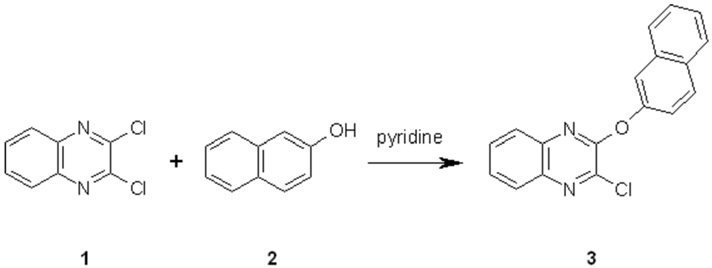
A mixture of 2,3-dichloroquinoxaline 1 [1] (1.0 g, 5 mmol) and 2-naphthol (0.72 g, 5 mmol) in pyridine (10 mL) was heated to 130°C for 3 h, with magnetic stirring, to give a dark-brown reaction mixture. The reaction mixture was allowed to cool and then poured into cold water (50 mL). The resulting solid was filtered, dried and purified by column chromatography on silica gel, eluting with petroleum ether (b.p. 100°) / ethanol (100:1) to afford 2-chloro-3-(2-naphthyloxy)quinoxaline 3 as colorless crystals (0.9 g, 58.0%).
Melting point: 163 – 165°C
1H-NMR (400 MHz, DMSO-d6, d (ppm): 8.10 – 7.90 (m, 5H, Ar-H), 7.76 – 7.67 (m, 3H, Ar-H), 7.62 – 7.54 (m, 3H, Ar-H).
13C-NMR (100 MHz, DMSO-d6, d (ppm): 152.8, 150.1, 138.8, 138.6, 133.5, 131.0, 130.8, 129.6, 128.5, 127.7, 127.6, 127.4, 126.8, 126.6, 125.8, 121.5, 118.1.
MS (m/z, %): 308 ([M + 2]+ 31.8), 306 (M+, 100), 278 ([M-CO] +,19.0), 271 ([M-Cl]+, 23.6), 243 ([M-CO-Cl]+, 34.6), 163 ([M-C10H7O] +, 8.6), 127 (17.3), 115 (50.3), 102 (45.6), 90 (12.0), 75 (22.2).
Supplementary materials
Supplementary File 1Supplementary File 2Supplementary File 3Acknowledgment
We thank the Alexander von Humboldt Foundation for a post-doctoral fellowship (C.A.O.).
Reference
- Obafemi, C.A.; Pfleiderer, Wolfgang. Helv. Chim. Acta 1994, 77, 1549–1556.
© 2006 MDPI. All rights reserved.